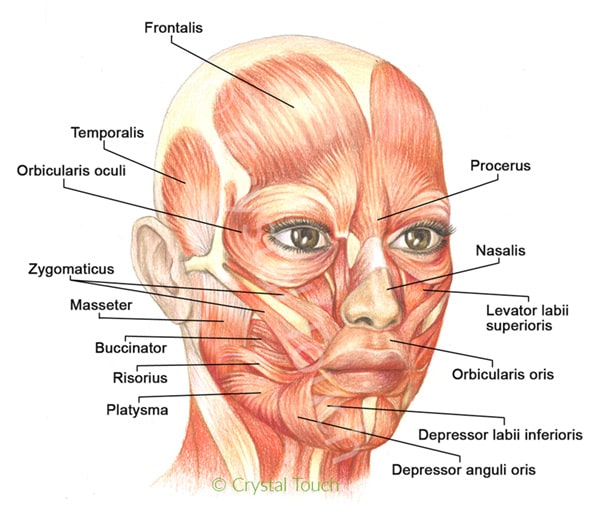Facial Anatomy

Facial Anatomy: Structures and Components
Facial Anatomy involves the bones (like the maxilla and mandible), muscles of expression and chewing, and nerves that enable sensation and movement.
Overview
The human face is the anterior portion of the head, extending from the forehead superiorly to the chin inferiorly, and from ear to ear laterally. It serves vital roles in communication, emotional expression, and identity. The anatomy of the face includes bones, muscles, fat, skin, nerves, and blood vessels.
Skeletal Structure
- The facial skeleton, or viscerocranium, consists of 14 bones:
- Paired bones: nasal, maxillae, inferior nasal conchae, palatine, lacrimal, and zygomatic bones.
- Unpaired bones: mandible and vomer.
- These bones provide shape and protection, serve as muscle attachment points, and contain openings for nerves and vessels.
Muscles of Facial Expression
- Approximately 20 muscles control facial expression, known as mimetic muscles, divided into five groups:
- Buccolabial group (e.g., orbicularis oris, zygomaticus muscles)
- Nasal group (nasalis, procerus)
- Orbital group (orbicularis oculi, corrugator supercilii)
- Epicranial group (occipitofrontalis, platysma)
- Auricular group (auricularis muscles)
- These muscles originate from bones or fascia and insert into skin, allowing expressions like smiling, frowning, blinking, and speaking.
Regions of the Face
- Superior region: Forehead (frontal region), orbital (eye) region, temporal region.
- Middle region: Nasal region (nose), infraorbital, zygomatic (cheek), auricular (ear) regions.
- Inferior region: Oral region (mouth), mental (chin), buccal (cheeks), parotid-masseteric region.
Soft Tissue Components
- Skin: Varies in thickness, thinnest on eyelids, thicker on forehead and cheeks.
- Fat Pads: Provide contour, cushioning, and youthful appearance (e.g., central forehead pad, lateral temporal pad).
- Superficial Musculoaponeurotic System (SMAS): Connective tissue layer integrating muscles with skin, important in facial surgeries.
- Nerves and Vasculature: Facial nerve branches control muscle movements; rich vascular supply maintains tissue viability.
Functions
- Protect delicate sensory organs (eyes, nose, mouth).
- Facilitate facial expressions, non-verbal communication, speech, and mastication.
- Provide identity and aesthetics.
Key Points
- The face comprises a complex interplay of bones, muscles, fat, nerves, and skin.
- Facial bones shape contours and provide points of muscle attachment.
- Mimetic muscles control expressions critical to human interaction.
- Understanding facial anatomy is essential for clinical, surgical, and aesthetic applications.
Consult with Our Team of Experts Now!
For advanced anatomical insights and personalized assessments related to facial anatomy in reconstructive or cosmetic procedures, consult with our specialized head and neck, plastic, and dermatology specialists.
References:
Hu KS, Chung KY. A Practical Review of the Muscles of Facial Mimicry With Special Considerations for Imaging. AJR Am J Roentgenol. 2014 Dec;203(6):W597-W604. doi:10.2214/AJR.14.12857. Available at: https://www.ajronline.org/doi/full/10.2214/AJR.14.12857















